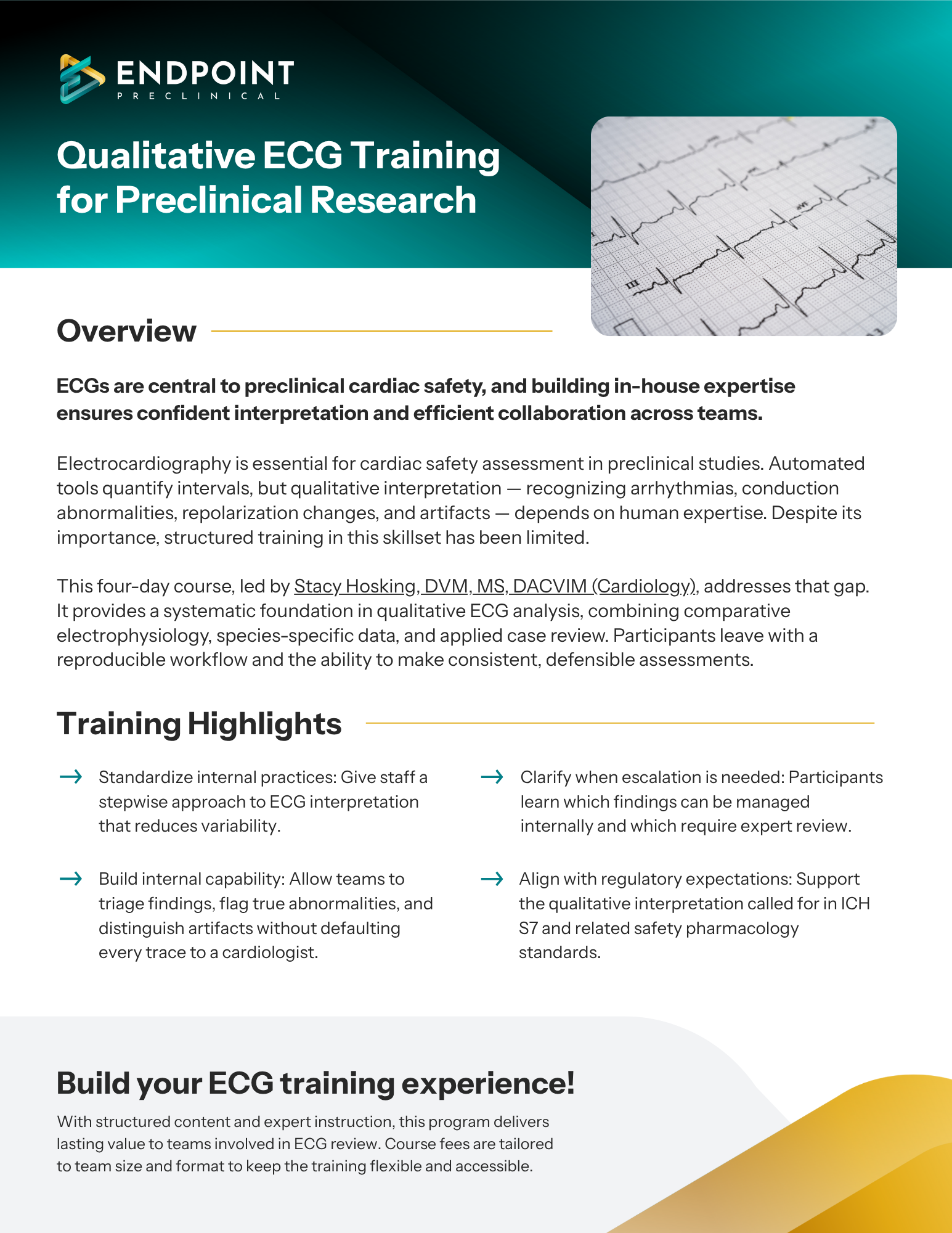Qualitative ECG Training for Preclinical Research
ECGs are central to preclinical cardiac safety, and building in-house expertise ensures confident interpretation and efficient collaboration across teams.
Electrocardiography is essential for cardiac safety assessment in preclinical studies. Automated tools quantify intervals, but qualitative interpretation — recognizing arrhythmias, conduction abnormalities, repolarization changes, and artifacts — depends on human expertise. Despite its importance, structured training in this skillset has been limited.
This four-day course, led by Stacy Hosking, DVM, MS, DACVIM (Cardiology), addresses that gap. It provides a systematic foundation in qualitative ECG analysis, combining comparative electrophysiology, species-specific data, and applied case review. Participants leave with a reproducible workflow and the ability to make consistent, defensible assessments.
Training Highlights:
- Standardize internal practices: Give staff a stepwise approach to ECG interpretation that reduces variability.
- Build internal capability: Allow teams to triage findings, flag true abnormalities, and distinguish artifacts without defaulting every trace to a cardiologist.
- Clarify when escalation is needed: Ensure participants know which findings can be managed internally and which require expert review.
- Align with regulatory expectations: Support the qualitative interpretation called for in ICH S7 and related safety pharmacology standards.
Course Structure & Topics:
This training is offered in flexible formats to fit your organization’s needs — whether as a four-day immersive, on-site program tailored to your studies and workflows; as live, multi-day virtual sessions designed for distributed teams; or as a hybrid model that blends online lectures with in-person case application. No matter the format, participants receive a comprehensive 400+ page workbook filled with species-specific examples, interpretation workflows, and case discussions — a lasting reference for continued practice.
- Cardiac action potentials, ion channel physiology, and conduction system anatomy.
- Leads, vectors, and axis interpretation across species.
- Stepwise workflow for evaluating rate, rhythm, intervals, and ST–T morphology.
- Baseline ECGs in large and higher order research models.
- Purkinje fiber distribution and its impact on QRS/T morphology.
- Background arrhythmia incidence by species — distinguishing normal from abnormal
- Recognition and correction of 60-cycle interference, panting artifact, baseline wander, and lead misplacement.
- Differentiating true arrhythmias from noise or equipment-related artifacts.
- Atrial arrhythmias: sinus arrhythmia, PACs, tachycardia, flutter, fibrillation.
- AV blocks: first-, second- (Mobitz I/II), and third-degree.
- Ventricular arrhythmias: PVCs, VT, VF, torsades de pointes.
- Electrolyte-driven changes (K⁺, Ca²⁺, Mg²⁺, Na⁺).
- Linking qualitative review to cardiotoxicity and regulatory endpoints.
- QT prolongation, repolarization changes, arrhythmia liability.
- Case examples from drug classes (anthracyclines, TKIs, vascular-disrupting agents).
- ECG manifestations of infarction in large and higher order research models.
- ST elevation, QT changes, arrhythmia susceptibility.
- Case discussions integrating infarction data into study decision-making.
The first step to building a custom ECG training program is providing information about your team, current gaps, and training goals. Click below to complete our questionnaire.
Alternatively, email your qualitative ECG training requirements to [email protected], and a member of our team will help build your training experience.
Instructor:
Stacy L. Hosking, DVM, MS, DACVIM (Cardiology)
Expert in Echocardiography, ECG Analysis, and Cardiovascular Consulting.
Dr. Hosking is a board-certified veterinary cardiologist with more than two decades of experience spanning clinical practice, preclinical safety pharmacology, and advanced cardiovascular imaging. She has held senior scientific and leadership roles in global research organizations, where she oversaw study design, cardiac endpoint evaluation, and investigator training.
Her expertise includes electrocardiography, arrhythmia recognition, echocardiography, and advanced imaging modalities, with a particular focus on applying these tools to large-animal models in translational research. She has delivered structured training programs, international lectures, and workshops, making complex cardiac electrophysiology approachable for multidisciplinary teams. View Stacy’s Profile
Frequently Asked Questions:
Flexible formats are available to match organizational needs:
- On-Site Training: Four-day immersive instruction, tailored to ongoing studies and workflows.
- Virtual Training: Live, multi-day sessions designed for distributed teams.
- Hybrid Models: A blended approach, with virtual lectures and in-person case application.
The course is intended for teams involved in ECG acquisition, review, and interpretation in preclinical studies:
- Study Directors and Investigators interpreting ECG findings in safety assessments.
- Veterinarians and Veterinary Cardiologists supporting translational and regulatory studies.
- Technical and Operations Staff who collect ECG data and conduct preliminary reviews.
- Scientists and Managers aiming to reduce dependence on external vendors for routine interpretation.
Participants complete the course with:
- Certificate of completion signed by Dr. Stacy Hosking.
- A comprehensive 400–500 page reference workbook with stepwise workflows, species-specific examples, and case discussions — a resource for continued practice long after the course.
- A structured, reproducible workflow for qualitative ECG interpretation.
- Increased capability to perform internal triage of ECGs.
- Clear criteria for identifying artifacts, arrhythmias, and drug-induced changes.
- A shared framework to reduce reviewer variability and strengthen team decision-making.



